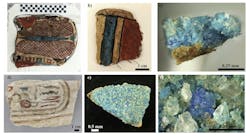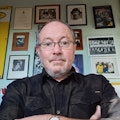Lost Pigment Recipe Opens Door to New Applications
First used over 5,000 years ago, Egyptian blue (EB) is thought to be the world’s oldest synthetic pigment.
The blue color, courtesy of its calcium copper silicate chemistry, was much in demand at the time. Beforehand, fashionistas keen on blue had to use expensive and rare stones such as turquoise and lapis-lazuli.
Human-made EB could not only simulate these but also had a much wider range of uses including in paints and the glazes used with ceramics.
The pigment’s color ranges from deep blue to dull grey or green depending on its ingredients — typically a silica source, lime, an alkaline flux and a copper source — and processing time.
After the Egyptians, the Romans used EB, before its manufacturing process and raw materials were lost to history.
Now a team of Washington State University-led researchers has re-created the pigment. What began as a request from the Carnegie Museum of Natural History in Pittsburgh to re-create ancient blue pigments for display purposes evolved into a broader collaborative effort.
John McCloy, director of WSU's School of Mechanical and Materials Engineering and first author on the research published in NPJ Heritage Science, said the project ultimately included partnerships with Smithsonian Institution researchers who conducted the final color measurements, while undergraduate students created the materials in the lab.
To understand its makeup, the researchers, including a mineralogist and an Egyptologist, created 12 different recipes of the pigment from mixtures of silicon dioxide, copper, calcium and sodium carbonate. They heated the material at about 1,000°C for up to 11 hours to replicate temperatures that would have been available for ancient artists.
After cooling the samples at various rates, they studied the pigments using modern microscopy and analysis techniques that had never been used for this type of research, comparing them to two ancient Egyptian artifacts.
They found that the pigment is highly heterogeneous.
“You had some people who were making the pigment and then transporting it, and then the final use was somewhere else,” said McCloy. “One of the things that we saw was that with just small differences in the process, you got very different results.”
In fact, to get the bluest color requires only about 50% of the blue-colored components.
“It doesn't matter what the rest of it is, which was really quite surprising to us,” said McCloy. "You can see that every single pigment particle has a bunch of stuff in it — it's not uniform by any means.”
The synthetic samples are currently on display at the Carnegie Museum of Natural History as part of the Stories We Keep exhibition, which highlights how modern science reveals hidden stories in ancient Egyptian objects.
There’s also another motive for the work. In recent years, there has been a resurgence of interest in the pigment because it has interesting optical, magnetic and biological properties with potential new technological applications, said McCloy.
The pigment emits light in the near-infrared part of the electromagnetic spectrum that people can't see, which hints at potential uses such as fingerprinting and counterfeit-proof inks. It also has a similar chemistry to high-temperature superconductors.
Not Going Nuclear
John McCloy, director of Washington State University’s School of Mechanical and Materials Engineering, and his team are no strangers to ancient materials. For nearly a decade they have been involved in the excavation of a hillfort in Broborg, Sweden.
Thought to be around 1,500 years old, the hillfort’s most unusual feature is its vitrified inner walls. Two materials known as dark glass and clear glass have been formed by different rocks being melted at temperatures from 850-1,250°C.
Quite how and why such vitrification took place is still up for debate, with incidental melting due to signal fires, lightning strikes, ritual destruction and construction fortification all in the mix.
The experts at Broborg favor the latter explanation, the hillfort builders subjecting the walls to high temperatures over several days to toughen them against any pyrotechnical plans hatched by enemies.
The WSU researchers’ role is to investigate how local rocks behave under various heating conditions but not entirely to solve an ancient vitrification riddle. Rather, they are looking at a thoroughly 21st century application: dealing with low activity waste (LAW) mainly generated by the nuclear industry.
“The idea is to use this glass as a long-term degradation analogue for the prediction of durability of vitrified nuclear waste,” he explained.
Broborg’s glasses are so like those used to vitrify LAW that they offer an unrivaled opportunity to investigate if and how the long-term chemistry of such glasses changes.
Another advantage with Broborg is that its environmental history is also reasonably well documented – because you don’t want to store your vitrified LAW somewhere with a history of flooding, earthquakes or volcanoes.
About the Author
Seán Ottewell
Editor-at-Large
Seán Crevan Ottewell is Chemical Processing's Editor-at-Large. Seán earned his bachelor's of science degree in biochemistry at the University of Warwick and his master's in radiation biochemistry at the University of London. He served as Science Officer with the UK Department of Environment’s Chernobyl Monitoring Unit’s Food Science Radiation Unit, London. His editorial background includes assistant editor, news editor and then editor of The Chemical Engineer, the Institution of Chemical Engineers’ twice monthly technical journal. Prior to joining Chemical Processing in 2012 he was editor of European Chemical Engineer, European Process Engineer, International Power Engineer, and European Laboratory Scientist, with Setform Limited, London.
He is based in East Mayo, Republic of Ireland, where he and his wife Suzi (a maths, biology and chemistry teacher) host guests from all over the world at their holiday cottage in East Mayo.


